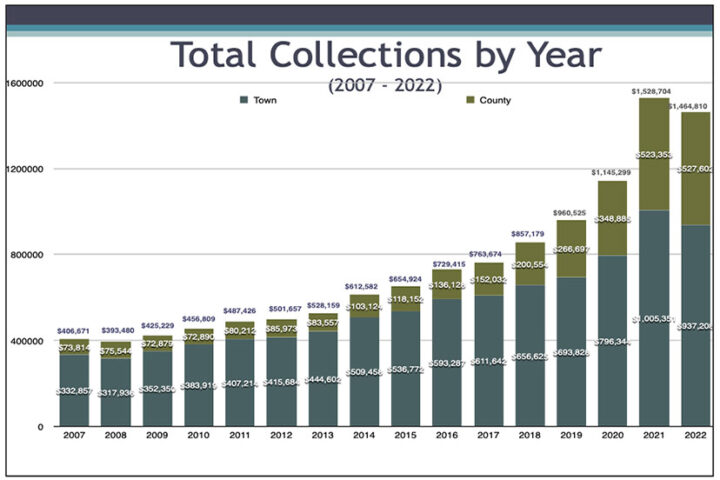In recent years, the role of destination marketing and management organizations in Colorado has evolved to not only support economic growth through tourism, but also to address the social, cultural, and environmental issues related to tourism…
— from House Bill 22-1117
Yesterday we looked at some issues facing La Plata County, and the tentative proposal in front of the commissioner there, to embrace the financial flexibility offered by House Bill 22-1117. The 2022 law allows counties to ask voter permission to spend lodging tax on community needs such as housing and child care, as well as on its traditional use: tourism marketing. Currently, La Plata County must spend its $1 million in annual lodging tax revenues only for “tourism marketing and advertising”.
HB 22-117 expands the allowable uses of the revenue from a local marketing district’s marketing and promotion tax and a county’s lodging tax to include:
- Housing and childcare for the tourism-related workforce, including seasonal workers, and for other workers in the community;
- Facilitating and enhancing visitor experiences; and
- Capital expenditures related to these new purposes.
A county must obtain voter approval to use lodging tax revenue for the new allowable uses. The state law is based upon the understanding that a tourism industry depends as much on a vibrant local workforce as it does on incoming visitors. And without housing and child care, the workforce is not likely to be as vibrant as it might be.
La Plata County currently allocates is $1 million in lodging tax revenues to an organization called Visit Durango.
A couple of thoughts from Ted Holteen, La Plata County’s representative on the Visit Durango board of directors… as summarized by Reuben M. Schafir in a recent Durango Herald article:
The Board of County Commissioners has not yet considered ballot language, Holteen said, nor has it specifically decided where the revenue might be directed.
He indicated that support for organizations providing child care seems to be the most likely use of money, given that the $500,000 would not make a significant dent in most affordable housing projects…
In 2020, the Town of Pagosa Springs purchased three acres behind Walmart, in the Aspen Village mixed-use subdivision, for $550,000. That parcel, if zoned R-22 and also granted a workforce housing density bonus, could accommodate up to nearly 100 affordable dwellings.
100 workforce housing units would be nothing to sneeze at. It might even be considered a “significant dent”.
I noted in Part One that Archuleta County — being a statutory county government — is currently required to use County lodging tax only for tourism marketing and advertising. The County allocates its 1.9% lodging tax to the Pagosa Springs Area Tourism Board, which creates the annual tourism marketing budget for our community. The County’s revenues come from tourist and travelers… mainly from bookings in Short-Term Rentals (STRs, vacation rentals) located outside the town limits in the unincorporated county.
The Town of Pagosa Springs collects a 4.9% lodging tax within the town limits, and likewise allocates the money to the same Tourism Board. In the chart below, the blue-green bars represent the Town’s collections; the olive-green bars, the County’s collections.

In 2021, the Tourism Board spent about $1.5 million on various tourism-related expenditures. It’s my understanding that, currently, the County’s allocation can be spent only on “marketing and advertising” while the Town’s contribution is more flexible and can be spent on “tourist related” things like employee housing and child care. (The Town is a Home Rule government, which the County is not.)
Also in 2021, the Town Council considered an ordinance that would have allocated “up to 50%” of its lodging tax revenues to workforce housing. That would have meant nearly $500,000 could be spent on the housing crisis. The Town considered asking the voters to approve the idea.
But the ordinance was never passed. However, my reading of the Town’s original 2006 lodging tax ballot measure allows the Town Council to do this kind of reallocation, without any need to pass an additional ordinance.
Archuleta County cannot currently pass a similar ordinance, to increase its lodging tax flexibility, because they have not yet asked the voters to approve the reallocation as required by House Bill 22-1117.
Do our community taxpayers favor using some of the County lodging tax for other purposes that can support the vitality of the tourism industry? Over in La Plata County, two recent surveys showed that around 85% of voters would support shifting the money away from tourism-marketing organization Visit Durango, according to an article in the Durango Herald.
That type of survey has not been done in Pagosa Springs. Nor have the voters been allowed to weigh in on making our lodging tax more flexible.
It’s possible the BOCC prefers to remain ignorant of how the voters feel about an ever-growing flood of tourists, attracted here by $1.5 million in annual expenditures by the Pagosa Springs Area Tourism Board.
As my father used to say, “Ignorance is bliss.”

